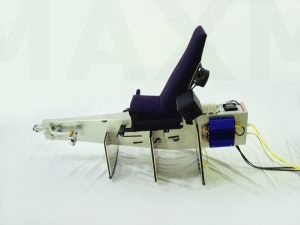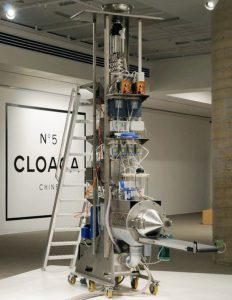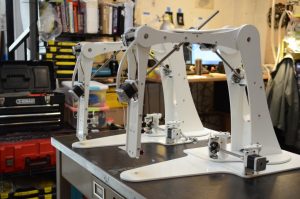My interests in physical computing are currently focused around robotics, bioengineering, simulations, and tangible interfaces. Accordingly, the following projects may serve as inspiration moving forward:
The EyeWriter
The EyeWriter is an open source eye tracking system that allows graffiti writers and artists with paralysis to draw using only their eyes. The project was implemented using a PlayStation Eye webcam, glasses frames, and custom software. Not only did this enable Tony Quan (aka TEMPTONE), who suffers from ALS, to create new works of art, the project’s creators used a projector to place his work on the side of a building in Los Angeles for others to appreciate.
This is an exemplary use of physical computing as a tool to help those with physical disabilities. That this project is a novel tool to help others create art, rather than serve as an art installation itself, is interesting as well.
Media Augmented Exercise Machine
The Media Augmented Exercise Machine is a design proposal for astronauts who must undertake many hours of exercise to adapt to microgravity environments. The machine allows a space traveller to explore a simulated terrain of their ultimate destination with a magnetorheological device that provides resistance from calculations of slope in the digital terrain. The prototype was well received by NASA personnel and a second prototype (in the form a recumbent bicycle) was produced for public exhibition.
This project is an excellent example of design intended for an extreme situation that also has more broad applications. Other exercise machines, such as rowers and trampolines, might be augmented in creative ways to encourage the general population to exercise more frequently and efficiently.
Cloaca No.5
The Cloaca is a robotic simulation of the human digestive system. The implementation involves motors, pressure sensors, and more to “chew” the food, contain bacteria to decompose it, and ultimately deposit the feces. According to its creator, the piece intends to have observers stop taking for granted this incredibly complicated biological process.
This use of physical computing serves as an educational tool regarding the human digestive process, provokes thought about the social stigma surround said process, and also successfully integrates biological components into a non-organic machine.
Huey-Dewey-Louie Climate Clock
This design is proposed self-building landscape that measures and tracks climate change. The three “characters” would continuously deposit chemicals from the atmosphere into the environment, annually collect samples of air, and collect daily soil samples using solar power. This would allow environmental information to be collected without needing to anticipate future sensorial requirements.
Though the specifics regarding implementation are sparse, this concept is notable for it scale and boldness of vision. It can be understood as a creative integration of physical computing into the natural environment.
Barista Bot
The Barista Bot is an interactive robotic experience that draws an individual’s face onto a latte. This project was implemented using a simple web cam, computer vision software, and servos. It was deployed at SXSW 2013.
This project is provocative in that it automates what can be, for some, a competitive craft. Further, it uses physical computing to augment beverage consumption, a daily (and typically unremarkable) experience.





Excellent set of projects! I have to say though that the Barista Bot’s foam on that cappucino/latte still leaves a lot to be desired! The humans at JOE probably still make better coffee. 🙂